Current evidence has shown that a large population of people in India practice open defecation and do not use toilets even when available. This lack of use has been attributed to the use of defective designs that do not take into consideration the engineering as well as hygiene aspects in terms of construction and maintenance, besides not taking into consideration the economic, socio-cultural, geographical, geohydrological and topographical aspects while constructing the toilets.
At the same time, there are many low cost models available in the country, but these continue to be poorly documented and tested. This workshop by Gramalaya was organised against this background and aimed at highlighting the efforts of organisations at developing appropriate and low cost technologies and drawing on these experiences and those of a wide range of participants, to develop low cost toilet models based on criteria like workability, durability, usability and maintainability aspects through a participatory process.
A video playlist of all the presentations made at the workshop
Background
Current evidence that a very large population in India continues to practice open defecation and that majority of the people do not use toilets even when available, has led to a re-evaluation of the sanitation goals at the national level in India. The national and the state governments are making sincere efforts to achieve 100% toilet coverage in the country.
There are many low cost toilets models available in the country that have been constructed by different agencies such as non-governmental organisations (NGOs), government, engineers and contractors, but these continue to be poorly documented and tested. On the other hand, defective designs without consideration to engineering, hygiene, as well as quality and sustainability have been constructed by utilising the subsides available from the government and international agencies. Experience has shown that these sub-standard and incomplete toilet structures are disused and discarded over a period of time by the community.
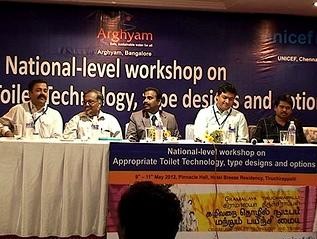
The inaugural session of the Gramalaya workshop: Speakers include Rahul Bakare, Director, Grants, Arghyam, Udayshankar, Director, Water.Org, Elangovan, Excecutive Director, Gramalaya, Arun Dhobal, WES Specialist, UNICEF and S Damodaran, Founder, Gramalaya
Why this workshop
Against this backdrop, Gramalaya organised a three day workshop on toilet designs, options and estimates at Trichy, Tamil Nadu, with support from Arghyam and UNICEF, which focused on designing different toilet types based on topographical and hydrogeological conditions by taking appropriate technologies into consideration. The workshop aimed at developing low cost toilet models based on criteria like workability, durability, usability and maintainability.
The workshop also intended to form a bridge between the experts in the sanitation sector such as engineers, architects and other professionals who were encouraged to take part in designing the layouts, estimates and construction materials based on the latest technologies available and the field workers, barefoot engineers who were involved in actual construction of low cost models, and combine the rich experience and expertise from both to arrive at better toilet models/designs through a participatory approach.
The workshop concentrated on dry toilets, wet toilets, ecosan, and urine diversion toilets including the septic tank models, which aimed at water conservation, groundwater pollution prevention with a focus on issues related to cost, durability and quality and planned to discuss toilet models for different terrains of India such as dry areas, water-logged areas, river banks, coastal, hilly and rocky areas.
Inaugural session
The inaugural session started with the welcome address by S Damodaran, Founder, Gramalaya, followed by an introductory speech by Elangovan, Executive Director, Gramalaya followed by a speech by Arun Dhobal, WES Specialist, UNICEF. This was followed by the keynote address by Rahul Bakare, Director (Grants), Arghyam followed by the special address by Udayshankar, Director, Water.Org.
The major points that came out during the inaugural session included references to the recent sanitation crisis in the country that led to lack of use of available toilets that had already been constructed in addition to a high proportion of people practising open defecation, which had become a social norm in the country. As a response to this, there was a strong leadership at the national level leading to efforts at restructuring the Total Sanitation Campaign (TSC) and the budget for sanitation had been thus increased.
The session highlighted that the demand for toilets had already been created at the policy level, which needed to be translated at the level of users. At the same time, technology in the form of construction of toilets had an important role to play in encouraging the use of toilets among people. The challenge was thus to focus on appropriate, user friendly and cost effective toilet technologies.
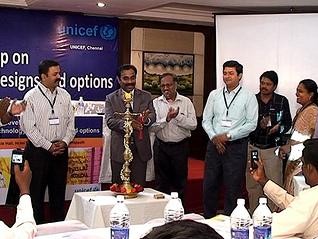
The inauguration of the workshop: Panelists included Rahul Bakare, Director, Programmes, Arghyam, Elangovan, Excecutive Director, Gramalaya, Udayshankar, Director, Water.org, , Arun Dhobal, WES Specialist, UNICEF, S Damodaran, Founder, Gramalaya and Geetha, Advisor, Gramalaya
It was thus important to dwell on questions like:
- What are the different types of toilet technologies, how appropriate is appropriate, who, what and how is important in designs/models and their applicability
- What are the approximate material and labour costs for different designs, can some generic costs be generated for each design, which could be applicable everywhere
- What types of designs were suitable for different geographical areas
It was hoped that the workshop would be helpful in answering some of these questions.
Expectations from participants and a group discussion on existing models and issues in developing and implementing appropriate toilet technologies
The first part of the session following the inaugural session included a general session on expectations of the participants from the workshop and was followed by group work that identified and discussed the issues or problems associated with implementing appropriate toilet technologies in the actual field.
Expectations of the participants from the workshop included:
- To arrive at an undertsanding of terms such as appropriate technology, cost effectiveness, applicability in the context of toilet use
- To discuss the toilet models in terms of appropriateness, cost and applicability for different geographical areas and circumstances and coming up with solutions
- To understand the process or mode of adapting new technologies to local contexts and circumstances, thus leading to a right toilet at the right place
Following this general discussion, the participants were divided into six groups and were asked to identify issues in developing and implementing toilet technologies in the following categories:
- Problems with usage and promotion
- Technical aspects
- Financial constraints and relevant opportunities
- Information, Education and Communication (IEC) and demand creation
- Support from the government
Group leaders were selected from each category and each leader was asked to present/share their experiences of the issues encountered while developing and implementing the technologies in the above categories in 10 minutes
Group 1: Problems with usage and promotion of technologies
The group discussed the problems faced at the user level while using technologies by presenting an example of a leach pit toilet. For example, this model had some inherent limitations and it was important to understand these before making the decision to use this model. For example,
- Many a times, the technical aspects were not taken into consideration and adhered to while using the model, which could lead to problems with its use in the long term. For example, no care was taken to keep the distance between the pit and the water source beyond 45 feet or adhere to specifications in terms of depth of the leach pit. This could lead to the risk of water contamination due to seepage of water, especially if the water source was near the leach pit toilet
- The model needed/ led to more usage of water, which was one of the limitations that had to be taken into account before taking the decision to use it
- It could lead to problems of overflow during the rainy season
- A leach pit was not suitable for all the types of soils or land. For example, they were not suitable for waterlogged areas
The group thus demonstrated how many a times, lack of attention to technical details and user considerations led to mere transfer of technology without consideration to appropriateness as well as information to the user on the long term usability and sustainability of the technology. It was thus very important to have an understanding of the area under consideration in terms of topography, the climatic conditions, the needs and behavioural patterns of the community where the technology was to be implemented and then evaluate the suitability and appropriateness of the technology in the area in terms of long term usability and sustainability.
Group 2: Technical aspects of toilet technology
The group highlighted the importance of technical aspects to make the use of any toilet technology successful and sustainable in the long term. Some of the important technical aspects that were highlighted included:
- The availability of well trained manpower on the basis of skills and knowledge
- The need for regular maintenance of the toilets
- Need for network systems for small habitations like Decentralised Wastewater Treatment Systems (DEWATS)
- Need to explore technical options for:
- Shared or group toilets
- Schools, anganwadi, college, festivals, bus stands etc., with facilities for water supply
- For emergencies and disaster management
- For people with disability, women, elderly and children
- Selection of toilets based on topography, geology, and water table conditions
- Exploring cost reducing technology options
- More research needed on developing technology for safe disposal of urine and excreta. For example, technology developed for converting urine into crystals
- The need to conduct more research on newer technologies such as technologies for Ecoscan etc
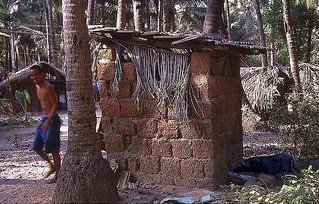
A rural toilet with thatched roof and brick walls
Group 3: Financial constraints and opportunity leverage
The group identified some of the financial constraints that led to lower financial commitment to the sanitation sector as compared to other sectors . These included:
- Sanitation was not considered as a priority sector
- Sanitation was a common need for all, there were no BPL/APL based needs or special needs, which did not lead to focus on the issue as important and urgent
- There was a huge knowledge gap among various stakeholders
- Low priority was accorded to awareness building activities or the software component in sanitation
- There was a huge technology gap and low consideration was given to appropriate technology leading to lower financial commitment
However, there were some opportunity leverages that could be identified and made use of such as:
- Tapping various government resources such as departments, specific schemes etc
- Networking of various stakeholders like donors, government and other financial institutions
- Non governmental organisations and microfinance institution tie up on watsan programme
- Encouraging internal lending through self help groups (SHGs)
Group 4: Information, Education and Communication (IEC) activities
It was emphasised that IEC activities had been given a very low priority and there had been no utilisation of the Total Sanitation Campaign (TSC) - IEC funds and the money continued to be unspent. However, it was important to understand that there was no uniform or a blanket IEC activity. The understanding, perceptions, sanitation and health behaviour and demands of community varied from place to place. It was thus important to revise and adapt IEC materials according to the needs of the community.
Besides playing a very crucial role and bringing about behavioural changes when directed at the entire community and different age groups, IEC could also play an important role in identifying suitable designs by the community, construction of toilets and also long term maintenance of toilets and be a useful tool for demonstrating how to build a toilet and help in bringing about a change in the behaviour of people. Besides, IEC could be very useful for following social mapping and identification of health and sanitation issues in the community and then identifying the vulnerable groups and designing IEC for the target groups. IEC could play a crucial role in explaining the importance and value of the use of toilet waste for organic farming and increasing agricultural production.
Thus,
- It was very important to prepare suitable IEC for children as children could be very valuable as change agents and help to carry the message to the community as a whole. IEC could be included in the school curriculum so that children knew the importance of sanitation
- Involvement of NGO’s for IEC activities with the support of the government could be very crucial
- IEC could also be promoted through self help groups (SHGs)
- IEC could also be encouraged through pre-play entertainment and short films by screening on real issues
- Compulsory screening of IEC advertisements in all channels could be taken up
It was emphasised that there needed to be provision in IEC to promote technological options, understand the needs of the target population, as well as the marginalised and vulnerable populations such as women, children, disabled, elderly etc. This was because people would be unable to choose for themselves unless they were provided with information on adequate options.
Group 5: Support from Government
The group informed that there were positive indications of the support by the government for sanitation activities in the form of:
- Increase in incentives/subsidies for toilet construction
- Increase in manpower
- Provision of adequate funds for sanitation through increase in budget for sanitation
- Emphasis on Information, Education and Communication (IEC) and provision of funds for IEC
- Encouragement for use of ecologically sustainable models of toilets such as Ecosan
However, there were a number of roadblocks in implementation due to problems such as delays in getting subsidies, problems of corruption, lack of management mechanisms leading to poor maintenance of school and anganwadi toilets due to poor water supply, emphasis on unit based targets that led to occasional slip backs. Some of the suggestions to deal with these drawbacks included convergence of sanitation schemes with the NREGA's such as social welfare schemes etc, limit on the subsidy processing to about 30 days with transfer through the bank, provision of loan linkages for building toilets, emphasis on information, education and communication activities at the school level, involvement of the media in spreading sanitation awareness messages and use of appropriate toilet designs to improve utilisation with emphasis on maintenance.
Low-cost sanitation technological options followed by national and international agencies
The group work was followed by presentations that described the experiences of a few national and international organisations in the sanitation sector at developing low cost sanitation technologies.
Toilet options in WaterAid: A presentation by Purna Chandra Mohanty
The basic requirements identified by WaterAid while designing appropriate technology options included:
- The technology should be such that excreta should not contaminate drinking water source
- The technology should be such that excreta should not be accessible to animals, flies, insects
- The technology should be free from odour or unsightly conditions (no water stagnation )
- Method should be simple and cheap in construction and operation
- It should ensure privacy, user-friendly to women, children and aged
- It should offer protection against weather and must be disaster resilient
The presentation highlighted the importance of factors to be considered that could influence toilet options such as the number of users and the intended duration for which the toilet was expected to serve the number of users, affordability among the users, the behaviours and the sociocultural practices among the users, the intended location of the toilet in terms of space, distance & accessibility, availability of local materials and local skills and other related and very important factors such as type of soil and soil absorbing capacity to select appropriate designs and prevent water logging, depth of the ground water table in the area to prevent contamination, availability of water supply to ensure use and maintenance of hygiene.
The presentation further highlighted the factors or important prerequisites to be taken into consideration while constructing toilets, which included understanding the importance of the location of the soak pit, which needed to be at least 10 metres from drinking water sources like open wells and shallow tube wells to prevent contamination, the need for maintaining the distance of minimum one metre between two soakpits to prevent leaching, ensuring that no water pipe line would pass across the soak pit as that could lead to contamination of water.
In addition to this, it was also important to ensure that the toilet location was close to the house for easy access of users, the toilet was well ventilated for maintaining cleanness and dryness. In addition to this, the site condition for safe excavation of pit as well as removal of digested excreta were also very important considerations, besides other aspects such as good planning in the construction, which would prevent entry of bath, kitchen and rain water into the soak pit.
The presentation went on to describe some of the experiences of WaterAid in the form of cases that demonstrated how appropriate, low cost and sustainable models were constructed by involving the community and taking into consideration the needs and constraints of the communities involved.
The video recording of the presentation can be viewed at the following links:
Experiences of Water Aid in designing and exploring appropriate toilet technologies - Part I
Experiences of Water Aid in designing and exploring appropriate toilet technologies - Part II
Low-cost sanitation and technological options followed by Gramalaya: A presentation by J Geetha, Gramalaya
This session included a presentation on the efforts undertaken and the experiences by Gramalaya in designing and promoting user friendly toilet technologies. The key points that emerged from the experiences were that bringing about behavioural changes among people and encouraging them to use toilets was not an easy, but a very challenging task. This was because people tended to have certain myths and misconceptions about toilets and it was thus necessary to bring about a behavioural change in people by educating the people on developing good toilet habits, which was a continuous process. Thus, the software component of the technologies was very important and thus, Information, Education and Communication (IEC) activities could play a crucial role in changing behaviour of the people.
Thus, the triad for IEC included:
- Access to information
- Access to technology
- Access to financial resources
Besides software, hardware aspects of toilet technology also had a major role to play in making toilet use and maintenance sustainable in the long run. Hardware aspects thus included:
- Toilet design
- Toilet pan
- Superstructure
- Technical standards
- Support services
- Linking local cement fabricators
- Linking masons
The presentation also went on to highlight the key issues that acted as limitations in designing appropriate and user friendly toilet technologies, which included the absence of locale specific toilet type designs with inclusion of cost estimates, inferior quality of construction materials produced by local cement fabricators, poor quality of construction by contractors without adequate knowledge on the type designs and cost estimates and toilet constructions by contractors with profit motive. It was thus important to focus on quality, affordability and appropriateness while designing toilets to ensure usability and sustainability of toilets in the long run, rather than merely focusing on quantity.
The presentation went on to describe different models designed by Gramalaya taking into consideration the local circumstances, the number of members present at the household level and involvement of people in the process.
The video recording of the presentation can be viewed at the following link:
Experiences of Gramalaya in exploring low-cost sanitation and technological options
Cost effective ecological sanitation toilets: A presentation by KY Babu, WASH Institute
This presentation described the role, importance and appropriateness of Ecosan toilets to deal with the current sanitation crisis in the country. The high cost was identified as one of the major hindrances in upscaling of the ecosan. The presentation went on to describe the different types of models used by WASH Institute, by working out the details of the materials used for construction and the costs involved in building the entire toilet structure. The models that were described along with their cost estimates and the contribution from the community included:
- Ecosan with mud block superstructure with plastering
- Double chamber bricks superstructure
- Ecosan with mud block superstructure
- Cement stone superstructure
- Tin sheet superstructure
Cost effective models for Ecosan
- Ecosan with hollow blocks superstructure
- Waste wood superstructure
- Nanal bamboo superstructure
- Palm leaf superstructure
- Coconut thatched superstructure
- Single chamber bricks superstructure
- Single chamber Thatched superstructure
It was found that:
- Ecosan with hollow block super structure seemed to be cost effective and at the same time a “pakka” structure with reasonable cost with the beneficiaries
- Single chamber with temporary super structure could be the lowest cost of Ecosan
- Using hollow block instead of bricks from the basement even upto squatting level could reduce a sum of Rs.500 in all the models
- A tin sheet with wooden reapers was used for the doors for all the Ecosan models. It was found that using the same material for doors in temporary super structures was found to further reduce the costs for toilets
- Changing the brick wall between the chambers (divider) also led to significant reduction in costs
- Avoiding pans made of ceramic or FRP and using cement mortar with hand finishing also led to significant reduction of costs for building toilets
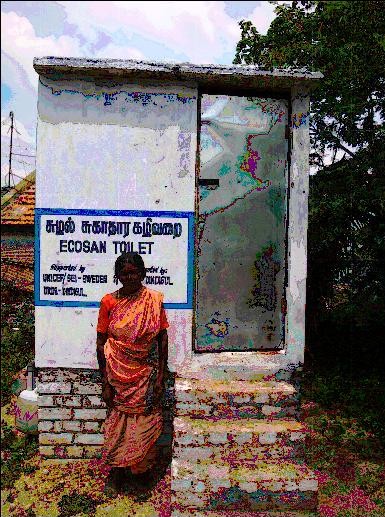
Ecosan toilet with mud block superstructure
However, there were a number of challenges faced while designing Ecosan toilets. For example, it was a challenge to construct Ecosan models for critical areas like coastal belts, drought prone and hilly areas and it was also a challenge to motivate people to use toilets in such conditions. Hesitation of the community to use ecosan toilets was one of the other problems encountered with their use along with other factors such as lack of technical knowledge regarding ecosan among the people and also the high costs involved in construction.
It was thus important to encourage and promote the use of ecosan toilets among the communities through introductions of special policies to promote Ecosan, adequate allocation of funds for IEC and its implementation, introduction of increase in subsidy for the promotion of Ecosan, devising ways to popularise Ecosan technology, including educating and equipping the masons and devising means for regular monitoring and support for Ecosan initiatives in the pre as well as post project implementation phase.
The video recording of the presentation can be viewed at the following link:
The experience of WASH institute in developing low cost ecosan toilet technologies - Part I
The experience of WASH institute in developing low cost ecosan toilet technologies - Part II
The experience of WASH institute in developing low cost ecosan toilet technologies - Part III
Total Sanitation Campaign: A presentation by P Veluswami, Consultant, UNICEF
Experiences from the Total Sanitation Campaign: A presentation
This presentation highlighted the Total Sanitation Campaign (TSC) effort in India and the barriers and limitations faced that led to limited success of the programme in achieving the goal of total sanitation in India. The presentation highlighted:
- The sanitation crisis in India and the inability of the current TSC programme to meet the sanitation needs of the people
- The inadequate number of toilets in urban and mainly rural areas and the high proportion of people resorting to open defecation in the country
- The high prevalence of water borne diseases attributed to poor sanitation leading to a very high economic burden on the country
- High presence of bacterial contamination of food and water sources in the country
The major challenges that the TSC faced included dysfunctional toilets, which could be attributed to lack of consideration and awareness of the technological aspects related to toilets. Thus , improper installation, choked toilets and pit leakages led to lack of use of toilets among the community. Lack of consideration to maintenance of toilets and poor management of the programme in terms of lack of skilled staff and lack of appropriate mechanisms to ensure utilisation of resources also led to dysfunctional toilets and consequently the poor use of toilets among the community. The other important limitation that the TSC faced included the perceptional barriers that people had regarding toilet construction and use and the lack of emphasis on Information, Education and Communication (IEC) activities in the programme, which led to less emphasis on the software component in the programme.
The presentation suggested the way forward by highlighting the importance of giving top priority to sanitation and increasing the budget for sanitation, increasing focus on community awareness building, behavioural change and local involvement, encouraging the involvement of women with focus on women’s dignity and promoting research on appropriate models to suit local circumstances and geography. The presentation ended by discussing some successful toilet models implemented by a few organisations.
The video recording of the presentation can be viewed at the following link:
Experiences with the implementation of the Total Sanitation Campaign in India - Part I
Experiences with the implementation of the Total Sanitation Campaign in India - Part II
Ecological sanitation: A presentation by M Subburaman from Society for Community Organisation and People’s Education (SCOPE)
The experiences of SCOPE in designing appropriate toilet designs: A presentation
The session started by a film that highlighted the importance of awareness among people to refrain from following the practice of open defecation and highlighted the need for ecosan toilets as one of the important ways of achieving sustainable sanitation through collection, processing and reuse of waste. The session highlighted that ecosan was an important form of sustainable technology suited to changing times, which was appropriate and adapted to suit local conditions. It was an integrated and holistic approach to the management of human excreta, which aimed at utilisation of the rich nutrients in both human urine and faeces.
Ecosan had gradually evolved over time from open defecation days through pit latrine, twin pit latrine, septic tank and underground drainage system to the decentralised, environmentally friendly ecological sanitation model. It had a number of advantages. Not only did it promote sustainable agriculture, but it also prevented contamination of surface and groundwater sources, conserved and preserved the most critical input for human life namely, water. The basic principle of ecological sanitation was thus to close the loop between sanitation and agriculture without compromising health.
The presentation went on to describe the experiences of SCOPE in developing ecosan models and the research undertaken by SCOPE to use urine as a fertiliser for increasing agricultural productivity, which indicated that the use of urine led to positive results with increase in agricultural productivity. Current research also indicated that it was possible to convert urine into struvite, a powdered form of urine and there was a possibility of having urine banks in the future to preserve urine and use it for agriculture. Thus, collection of urine at the community level could be encouraged.
However, there were a number of social and cultural barriers associated with the use of ecosan toilets among the community because of the bias that people had about the use and handling of urine and faeces and it was thus important to increase community awareness to overcome this barrier. The discussion that followed highlighted the effort undertaken by one farmer in Aurangabad who used urine as a fertiliser, which resulted in better yield of crops and identified some of the drawbacks and steps that needed to be undertaken to increase use of ecosan toilets among people. Thus, the discussion highlighted the importance of providing information on the design and use of the toilets and the proper methods related to collection and processing of urine among the users, proper technical training of the people using ecosan toilets and the need to increase community awareness and bring about behavioural change in the community to encourage them to use ecosan toilets.
Besides information, research and innovation were important and at times could help to overcome the barrier of usability issues. Thus, emphasis had to be placed on constant innovation to improve usability of the models in the future.The group also discussed the methods and means that could be employed to collect urine on a large scale in cities such as having collection centres at bus stops etc and in rural areas. The discussion also highlighted how people, especially farmers could be informed on how urine could be used directly in the fields, there was enough information on the scientifically proven dilutions of urine that could be used for agriculture, these could be obtained from Arghyam. At the same time, research was needed to find out the impact of urine quality on handling of urine in case of diseases etc.
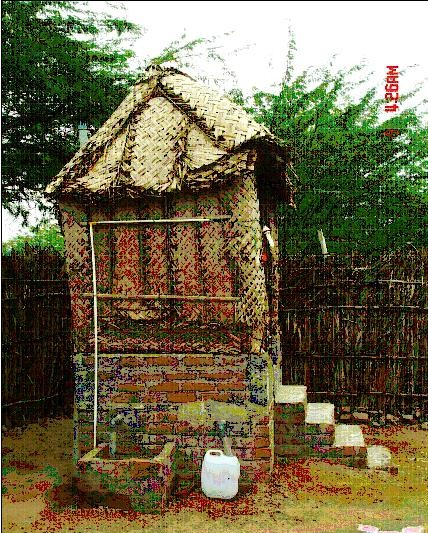
Ecosan toilet with thatched roof superstructure
The video recording of the presentation can be viewed at the following links:
Experiences of SCOPE in developing and conducting research on ecosan models - Part I
Experiences of SCOPE in developing and conducting research on ecosan models - Part II
Experiences of SCOPE in developing and conducting research on ecosan models - Part III
Group work and presentations on selection of appropriate and cost effective toilet options according to different geographical, socio-economic conditions
The presentations were followed by groupwork, which aimed at conducting a short exercise that focused on designing or developing appropriate and cost effective prototypes or models, which could be suitable for different sociocultural, economic contexts and geographical locations. The aim of this group work was to develop an understanding of how to design an appropriate toilet by taking into consideration the range of software and hardware components as well as paying attention to the cost components while designing the toilet. It was hoped that the learnings from the earlier sessions as well as the range of expertise that the participants brought to the workshop, would be useful in implementing this practical exercise.
The groupwork started by introduction to a calculator on costs of toilets developed by Arghyam and it was decided that this would be tested to find out if it could be used in practice during the group work exercises that aimed at selecting appropriate designs and cost estimated according to contexts and geographical locations. For the exercise, the participants were grouped according to the type of models they were going to work on such as:
- Biogas FRP model
- Improved leach pit model
- Ecosan toilet
- Single pit toilet
- Toilet with attached bathroom
- Toilets for disasters and emergencies
The Biogas FRP model
The group presented their diagram on the construction of the Biogas FRP model and highlighted the advantages of the model such as cost effectiveness, the ecofriedly nature of the model and the usefulness of the model in soil conservation. The technical aspects of the models such as how to prevent leakage of gas in the model, what kind of material could be used for the biogas plant were also discussed during the presentation. The disadvantages of the model such as lack of awareness among people in using this model, need for space and livestock, rise in costs on consideration to superstructure, limitations such as the quality and capacity of the model cannot be measured were also discussed.
Improved leach pit toilet model
The group presented their diagram on the construction of the improved leach pit toilet with cost estimates.It was discussed that the leach pit toilet could be used in all soil conditions, but it could lead to soil and water contamination Ecosan was nothing but an improved leach pit model and this toilet could be used by four people for 10 to 15 years.
Ecosan toilets
The group presented their models and highlighted the fact that ecological sanitation “eco-san” was a concept and package of technologies that aimed at:
- Reducing the use of water in sanitation practices
- Recycling human wastes into resources
- Re-using the resources in agriculture and horticulture
Advantages of using ecosan toilets included:
- Faeces could be used as manure
- Urine could be used as fertiliser
- Led to less water consumption
- Was eco friendly
- There was no risk of ground water pollution
- Required very less maintenance
- No sewage treatment was needed
- The cuts from the toilets could be useful in making kitchen gardens
- Could be used in rockyareas/coastal areas/areas with water logging/areas with high water table/ in areas with water scarcity
Disadvantages of using ecosan toilets included:
- Use needed motivation among people
- Needed proper maintenance, else it could give rise to bad odours or stink
- It required more space
- One had to be acclamatised to the use of Ecosan toilets, else it could be uncomforrtable for new users
- It could be expensive
- Cultural barriers from the point of view of users as there could be hesitation from the point of view of users to touch manure and urine
The Ecosan models discussed included:
- Double Chamber with hollow block
- Single Chamber with barrel
- Double Chamber with ramp for differently abled persons
Single pit with roof super structure model
The group discussed the models designed by them and highlighted the merits and demerits of the models/designs.
The merits of this model included:
- Sustainability
- Cost effectiveness
- Utilisation of locally available materials possible
- Needed less space
- It could be used by users from all age groups and could be used in all seasons (rainy, summer)
The demerits included:
- Not recommended for hilly, rocky and wet areas
- Unsuitable for water scarce areas
- Not easily usable for physically handicapped
- More risk of water pollution
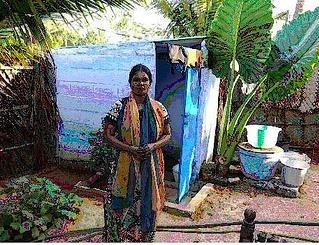
Toilet with attached bathroom and kitchen garden
Toilets with attached bathroom
The advantages of these toilets that were highlighted included:
- Bathroom attached toilet, which was more convenient
- Possibility of continued usage due to facility for construction of second pit
- A very long life span of around 50 years
- Soak pit provided for grey water treatment
- Saved money & space
- Included provision of incinerator for disposal of used napkins
Disadvantages included:
- Cost wise on higher side with the amount ranging to Rs. 13,600
- One person utility at a time
Toilets in disasters and emergencies
Four types of models were discussed, which included:
- Direct trench type
- Trench type with squatting plate
- Circular type community toilet
- On pit raised platform type
Direct trench type
Advantages included:
- Easy to construct and time required for construction was less
- Unskilled local labour could be used
- Less material cost
- Locally available material could be used
- Most suitable for immediate access
Disadvantages:
- Could not be upgraded and short term use
- In case of poor use, foul smell was possible
- Water use had to be just appropriate
- It was not suitable for rocky terrain, water logged areas
- There was a possibilitiy of damage by animals
- Difficult for use by children
Trench type with squatting plate
Advantages included:
- Easy to construct
- Could be used for a comparatively longer period
Disadvantages:
- Squatting plate needed to be made available immediately
Circular type community toilet
Advantages:
- Less space required
- Leach pit type so manure could be extracted
- Water availability could be ensured
- Transportable if pre-fabricated
Disadvantage
- Immediate availability of squatting blocks could be a problem, this needed to be stored in the warehouse and made available immediately on need
On-pit raised platform type
Advantages
- Ground water contamination could be avoided throughout the flood period
- Could be individual or family centric
- Could be accessed throughout the year, even during the floods
Disadvantages
- Additional cost burden
- Risk of contamination
The video recordings of the groupwork presentations can be viewed at the following links:
Appropriateness, cost, advantages and disadvantages of the improved leach pit toilet model
Appropriateness, cost effectiveness, advantages and disadvantages of ecosan toilet models - Part I
Appropriateness, cost effectiveness, advantages and disadvantages of ecosan toilet models - Part II
Appropriateness, cost effectiveness, advantages and disadvantages of ecosan toilet models - Part III
Appropriateness, cost effectiveness, advantages and disadvantages of single pit toilet model
Advantages, disadvantages and cost effectiveness of toilet with attached bathroom
Appropriate and cost effective toilet models for emergency situations - Part I
Appropriate and cost effective toilet models for emergency situations - Part II
Appropriate and cost effective toilet models for emergency situations - Part III
A video playlist of all the presentations
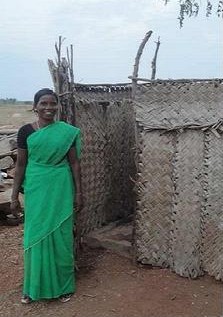
Temporary toilet with thatched walls
Open house discussion
The presentations were followed by an open house discussion, which was intended to be a participatory exchange of ideas or a discussion on queries that the participants had. The main points that were discussed included:
- The importance of sanitation technologies to prevent disease and the importance of understanding the F diagram of disease transmission and control
- The importance of understanding behavioural aspects of sanitation while designing toilet technologies
- Characteristics of human excreta
- The importance of plastering the top six inches of a leach pit to prevent faecal larva from travelling upwards and sandbed plastering on the sides and bottom to prevent pathogens from travelling downwards
- Differences between leach pit, septic tanks and Ecosan models
- The importance of desludging of the septic tank at regular intervals and scientific management of sludge
- Toilet technologies currently proposed to be used in trains
Valedictory function
The workshop ended with the valedictary function that included reflections and feedback on the workshop and the way forward.
The presentations from the workshop can be downloaded from below:
 total_sanitation_campaign_veluswamy_2012.pdf
total_sanitation_campaign_veluswamy_2012.pdf toilet_options_practised_in_wateraid_purna_chandra_mohanty_2012.pdf
toilet_options_practised_in_wateraid_purna_chandra_mohanty_2012.pdf low__cost__sanitation_technological_options_followed_by_gramalaya_2012.pdf
low__cost__sanitation_technological_options_followed_by_gramalaya_2012.pdf cost_effective_ecosan_toilets_k_y_babu_2012.pdf
cost_effective_ecosan_toilets_k_y_babu_2012.pdf ecosan_toilet_group_3_presentation_2012.pdf
ecosan_toilet_group_3_presentation_2012.pdf toilet_with_attached_bathroom_group_5_presentation_2012.pdf
toilet_with_attached_bathroom_group_5_presentation_2012.pdf ecosan_uddt_scope_m_subburaman_2012.pdf
ecosan_uddt_scope_m_subburaman_2012.pdf single_pit_with_roof_super_structure_model_group_4_presentation_2012.pdf
single_pit_with_roof_super_structure_model_group_4_presentation_2012.pdf toilets_in_emergencies_disasters_group_6_presentations_2012.pdf
toilets_in_emergencies_disasters_group_6_presentations_2012.pdf the_f_diagram_of_disease_transmission_and_control_the_gramalaya_workshop_on_appropriate_toilet_technologies__2012.pdf
the_f_diagram_of_disease_transmission_and_control_the_gramalaya_workshop_on_appropriate_toilet_technologies__2012.pdf national_workshop_on__appropriate_toilet_technologies_programme_schedule_gramalaya_2012.pdf
national_workshop_on__appropriate_toilet_technologies_programme_schedule_gramalaya_2012.pdf












